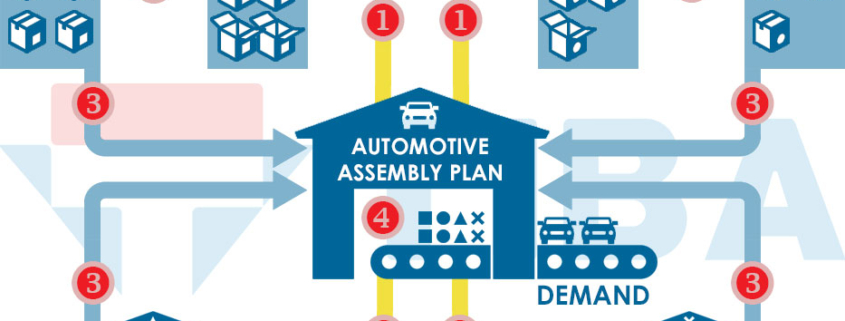The Kanban System in the Automotive Industry

Kanban System: Controlling the Flow of the Automotive Supply Chain
There are 2 names associated with the history of the automotive industry: the first is Ford, who helped to industrialize vehicle production on a large scale. The second is Toyota, which established a method for supplying automotive parts to satisfy demand by means of the Kanban Inventory Control System.
The Kanban System was invented by Toyota to optimize its vehicle production supply chain. It consists of several consecutive phases that must be fully completed before moving to the next phase in order to ensure the quality of the final product. This means that if we have come to the final phase of the Kanban chain, then all the other phases must have been completed successfully.
Procedures in the Kanban System
The Kanban System is considered a formalization of the JIT (just-in-time) method. Kanban’s greatest contribution is the “PULL” method, meaning that inventory is requested based on demand as ordered, as opposed to the “PUSH” system, in which inventory is sent to the assembly plant based on forecasted need, not taking into account the actual need.
The Kanban System is organized using a series of cards in order to execute each phase. These cards or labels state what phase of the vehicle manufacturing process the goods are currently in. There are three main labels:
- Withdrawal Kanban (K1):This is the order made to the provider based on production needs.
- Production Kanban (K2):This is the order for the provider to manufacture pieces, based on the withdrawal Kanban issued by the assembly plant.
- Transport Kanban (K3):This is the order to transport these pieces to the assembly plant.
K1, K2, and K3 are names used to illustrate this procedure based on the following system:
1. The assembly plant has a specific need for parts. Before they run out, the plant issues an order to each provider with the exact demand quantity (withdrawal Kanban).
2. Each provider (in this case, the tier 1 and 2 suppliers) manufactures the goods based on the request received. It does so through a production order (production Kanban).
3. The automotive parts are sent to the assembly plant based on said demand (transport Kanban).
4. The assembly plant receives these parts without interrupting its production.
The main advantage of the Kanban System is that it can absorb variations in the flow of demand as a function of highs and lows in production. In addition, the Kanban System sees the entire production line as a single process, assembling one piece (a vehicle) across the entire cycle without any interruptions or wastefulness.
To summarize, there are five rules in the Kanban System:
- When the assembly plant is about to run out of a part, a withdrawal Kanban is issued.
- The parts are only produced in the quantities requested in the Kanban.
- Nothing is produced or transported without a Kanban order.
- All batches of parts are associated with a Kanban.
- The more productive this process, the fewer Kanban cards in circulation.
Many different terms are associated with the automotive industry (JIT deliveries, JIS deliveries, hand carriers, control tower, etc). It is important to have the assistance of an expert on the topic so you won’t get lost with these unfamiliar concepts. At TIBA, we are experts in automotive logistics, and we’re here to help with your production flow and management. Contact us today!












Leave a Reply
Want to join the discussion?Feel free to contribute!